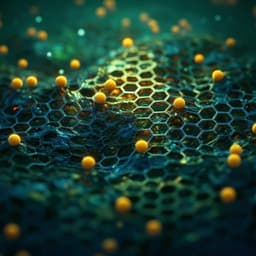
Engineering and Technology
An artificial spiking afferent nerve based on Mott memristors for neurorobotics
X. Zhang, Y. Zhuo, et al.
Explore groundbreaking research by authors Xumeng Zhang, Ye Zhuo, Qing Luo, Zuheng Wu, Rivu Midya, Zhongrui Wang, Wenhao Song, Rui Wang, Navnidhi K. Upadhyay, Yilin Fang, Fatemeh Kiani, Mingyi Rao, Yang Yang, Qiangfei Xia, Qi Liu, Ming Liu, and J. Joshua Yang. This paper introduces an artificial spiking afferent nerve (ASAN) that adapts its spiking frequency in response to stimuli intensity, showcasing potential for self-aware neurorobotics.
~3 min • Beginner • English
Introduction
The rapid growth of sensory data in the era of big data and IoT demands real-time, energy-efficient processing, which challenges von Neumann architectures. Spiking neural networks (SNNs) promise high efficiency and capability, and recent hardware realizations span digital, CMOS analog, and memristive devices. Yet, a critical missing interface is an artificial afferent nerve that converts continuous analog sensory outputs into spike trains suitable for SNNs. This study proposes and experimentally demonstrates an artificial spiking afferent nerve (ASAN) based on NbOx Mott memristors that performs analog-to-spike conversion with biologically relevant dynamics, including proportional firing with innocuous stimuli and protective inhibition under noxious stimuli. The work further integrates ASAN with a passive piezoelectric tactile sensor to realize a power-free spiking mechanoreceptor, aiming toward self-aware neurorobotic systems.
Literature Review
Prior work has developed hardware SNNs using digital logic, CMOS analog circuits, and memristors, with memristors offering high density, low power, analog behavior, and rich dynamics. Memristor-based synapses and spiking neurons have been demonstrated. Interfaces that convert analog sensory signals to spikes are less explored; a bio-inspired organic ring oscillator afferent nerve controlled biological motor nerves through a synapse transistor, and devices have emulated nociceptors, mechanoreceptors, and opto-sensorimotor synapses. However, a compact artificial spiking afferent nerve that broadly transforms sensed analog inputs into spikes is still needed. NbOx memristors exhibit negative differential resistance and threshold switching suitable for oscillators and neuron emulation, motivating their use here.
Methodology
Device and materials: The memristor is a 3D vertical metal–insulator–metal device with TiN top electrode, NbOx switching layer (~25 nm), and a low-thermal-conductivity polysilicon (poly-Si) bottom electrode (SiO2/Si/SiO2 multilayers: 150/60/150 nm). Top electrodes are ~40 nm TiN with ~20 µm width defining the lateral dimension; channel length is set by 60 nm poly-Si thickness. Fabrication involved PVD/PECVD deposition, single-step etch for the poly-Si bottom electrode sidewall, magnetron sputtering of NbOx and TiN, and lift-off for the top electrodes. TEM and EDS mapping identified a ~8 nm diameter crystalline NbO2 channel formed after electroforming. Forming and electrical characteristics: Devices were irreversibly formed by a DC sweep 0–5 V, reducing low-bias resistance from 56 GΩ (@1 V) to 35 MΩ (@1 V). Threshold switching shows ~2 µA threshold current, with VTH ≈ 2.05 V and VH ≈ 1.53 V under triangular sweeps (2.5 V/100 µs). Bi-directional, nonpolar switching was observed. A Joule-heating-driven NDR mechanism underlies the transition between LRS and HRS. ASAN circuit: The ASAN combines a resistor Rc = 75 kΩ in series with the NbOx memristor; the node between Rc and the memristor serves as both input (via Rc) and output (spike readout). Total parasitic capacitance Cparasitic ≈ 20 pF in test setups dominates over the intrinsic device capacitance (<1 pF). Operation relies on leaky integrate-and-fire dynamics: the node capacitance charges through Rc while the device is in HRS until Vnode exceeds VTH, causing a swift transition to LRS and rapid discharge until Vnode falls below VH, at which point the device returns to HRS and integration resumes. Endurance was assessed by continuous operation for ~106 s with period <1 µs, implying >1012 cycles without failure. Measurements: For single-device I–V and Fig. 3 experiments, an Agilent B1500A was used. For ASAN with external capacitors (4.7 nF and 47 nF), a Keysight 81160A generated input stimuli and a Keysight MSO-X 3104T oscilloscope recorded input and output. For the mechanoreceptor, an off-the-shelf piezoelectric device provided input voltage from applied finger pressure; signals were measured with the same oscilloscope. Stimuli protocols: Constant DC inputs from ~2.0–>6 V, triangular ramp inputs (1.9–2.5 V, 1 V/ms), sinusoidal inputs with and without DC bias, and pressure-induced waveforms from the piezoelectric sensor. The external capacitor facilitated operation in convenient frequency ranges (4.7 nF for kHz; 47 nF for Hz–kHz). Modeling: A biphasic memristor LTspice model (after Pickett & Williams) was implemented, assuming cylindrical symmetry, constant temperature in the metallic core at transition temperature, ambient temperature outside, and 2D radial heat flow. The total resistance Rt depends on metallic phase fraction u (ratio of channel radius to metallic core radius). Dynamics follow du/dt governed by system enthalpy ΔH, thermal conductance Ith, temperature rise ΔT, and Rt(u). Expressions for Rt, du/dt, ΔH, Ith, and dΔH/du were used to simulate device switching and oscillator frequency-voltage characteristics, matching experiments. Energy analysis: Energy per spike was determined by integrating power over time and dividing by spike count; minimum ~38 pJ/spike was measured. Parameter variations: The ASAN was also evaluated with different capacitors (4.7 nF and 47 nF) to target frequency bands including the human nervous system (1–1000 Hz).
Key Findings
- An artificial spiking afferent nerve (ASAN) based on a NbOx Mott memristor and a single resistor converts analog voltages into spike trains with leaky integrate-and-fire dynamics.
- The ASAN exhibits a quasi-linear increase of spiking frequency with input intensity in an excitatory regime, followed by decreased frequency and eventual cessation of spiking (protective inhibition) at higher, noxious input levels.
- With on-board parasitics (~20 pF) and Rc = 75 kΩ, oscillations begin when input exceeds ~2 V; frequency rises with voltage (Fig. 3c–d, 3e–f). Under a triangular ramp (1.9–2.5 V, 1 V/ms), frequency tracks voltage quasi-linearly.
- Energy efficiency: minimum measured energy consumption per spike ~38 pJ.
- Endurance: continuous operation for ~10^6 s with period <1 µs; device remained functional afterward, implying >10^12 switching events.
- With an external 4.7 nF capacitor, frequency increases quasi-linearly from input 2.6 V to 4.8 V, then decreases and stops oscillating at ~6.2 V as the device holds ON (protective inhibition). A separate test showed stop-spiking at ~5.9 V due to VH variability (1.62 V vs. 1.71 V).
- Sinusoidal inputs (with and without DC bias) produce sinusoidal-like frequency modulation; protective inhibition occurs at higher amplitudes and recovers when input subsides.
- Using a 47 nF capacitor, the ASAN covers 0–1100 Hz, matching the human nervous system frequency range (1–1000 Hz).
- Power-free mechanoreceptor: integrating a piezoelectric tactile sensor with ASAN yields a self-powered artificial spiking mechanoreceptor system that converts pressure into spikes; peak firing rate increases with pressure intensity and halts under excessive force (protective inhibition).
Discussion
The ASAN addresses the critical interface gap between analog sensory outputs and spike-based neuromorphic processors by providing a compact, two-terminal memristor-based oscillator that encodes stimulus intensity into firing rate, akin to biological afferent nerves. The quasi-linear rate coding at innocuous levels enables straightforward mapping from sensor amplitude to spike frequency, while protective inhibition at high intensities emulates neuronal safety mechanisms and prevents device over-stress by latching in the ON state. The memristor’s intrinsic NDR and thermal dynamics provide desirable leaky integrate-and-fire behavior with minimal component count, promising high-density integration and low power compared to CMOS ring oscillators. Demonstrations with DC, triangular, and sinusoidal inputs, as well as a passive piezoelectric sensor, validate robust operation across realistic analog signal forms and show feasibility for self-powered sensory front ends in neurorobotics. Matching human-range spiking frequencies via capacitance scaling points to applicability in human–machine interfaces and bio-inspired sensing.
Conclusion
This work demonstrates a compact artificial spiking afferent nerve based on NbOx Mott memristors that converts analog inputs into spike trains with biologically analogous rate coding and protective inhibition. The device sustains >10^12 switching events, achieves ~38 pJ/spike minimum energy, and supports diverse stimuli waveforms. Integration with a piezoelectric transducer yields a power-free spiking mechanoreceptor converting pressure to spikes, with firing rates proportional to force until inhibition under noxious levels. The approach can generalize to other sensory modalities (e.g., chemical, optical, thermal, magnetic, humidity) and can serve as a building block for spiking neurons and coupled oscillator networks. Future research should optimize device parameters (lower VTH and narrower VH–VTH window), reduce parasitic capacitance for lower energy, explore on-chip integration with sensor arrays and SNNs, and investigate variability mitigation and large-scale system demonstrations in neurorobotics.
Limitations
Device behavior depends on threshold and hold voltage variability (e.g., different VH values shifted the stop-spiking voltage from ~6.2 V to ~5.9 V). Test circuits exhibited external parasitic capacitance (~20 pF), and an external capacitor was used to reach desired frequency bands, indicating system-level capacitance significantly influences dynamics and energy. The forming step is required to create the NbO2 channel, and TEM sampling suggests channel geometry may vary. Energy per spike, while low, could be further reduced with optimized devices (lower VTH, narrower VH–VTH) and minimized parasitics. Demonstrations focused on a single device and discrete components; large-scale integration, long-term stability under diverse environmental conditions, and cross-device variability were not comprehensively characterized.
Related Publications
Explore these studies to deepen your understanding of the subject.







